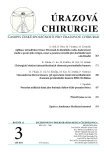Injury of soft tissues as limiting factor in treatement fractures of lower leg
Authors:
Jan Spudich
Authors place of work:
Chirurgické oddělení Nemocnice Most, o. z., Krajská zdravotní a. s.
Published in the journal:
Úraz chir. 21., 2013, č.3
Summary
BACKGROUND:
Injury of lower leg has his specifics first of all because of the injury of soft tissues. The choice of implant and timing of definitive solution of soft tissue defects are the basic keys in treatement algorithm.
MATERIAL AND RESULTS:
Author gives hereby the experience from his departement with the treatement of lower leg injuries in the last 10 years.
DISCUSSION:
The injury of soft tissues is strongly dependent on the level of lower leg. Fast and correct solution of the injury of soft tissues plays the key role. The right timing of definitive osteosynthesis is crucial.
CONCLUSION:
The correct common solution of soft tissue injury by fractures of lower leg is the key factor which influence the final prognosis of the treatement. In the level of proximal and middle third tibia it is possible in most cases to treat the injury of soft tissues and provide osteosynthesis in one procedure. On contrary by fractures of distal third tibia and first of all by pilon fractures it is necessary to use often more phases. It is crucial to solve the soft tissue injury definitively in the period of 1 week.
Key words:
soft tissues, level of lower leg, soft tissue cover.
Zdroje
1. AHMED, B., DIN, MD. Distally Based Sural Fasciocutaneous Flap for Coverage of Foot Defects. J Plast Reconstr Surg. 2006, 2, 93–99.
2. GUSTILO, RB, ANDERSON, JT. Problems in the management of type III open fractures, a new classification of type III open fractures. J Trauma. 1987, 24, 742–746.
3. HEPPENSTAHL, RB. Compartement syndrome. Diagnosis and Treatment-Techniques Orthop. 1997, 12, 92–108.
4. MUBARAK, SJ., OWEN, CA. Double-incision fasciotomy of the lower leg for decompression in compartement syndrome. J Bone Joint Surgery Am. 2008, 59, 184–187.
5. LEVIN, ST., CONDIT, DP. Combined injuries- soft tissue management. Clin Ortop Related Res. 1996, 327, 172–181.
6. NEJEDLÝ, A., DŽUPA, V.,TVRDEK M. Využití muskulárního laloku při léčení infikovaných zlomenin a chronické osteomyelitidy v oblasti bérce a hlezna. Acta Chirurgiae Orthopaedicae et Traumatologiae Čechoslovaca. 2007, 74, 162.
7. RUEDI, T., BUCKLEY, R., MORAN, CH. AO Principles of Fracture Management. 2007, 1 sv., 86–108.
8. TŘEŠKA, V., ČECHURA, M., ČERTÍK, B. Poranění končetinových cév, naše zkušenosti a výsledky. Rozhledy v chirurgii. 2002, 1, 7–10.
9. TSCHERNE, H. Wound management of fracture with soft tissues damage. Chirurgie. 1983, 38, 34–39.
10. VESELÝ, R., PROCHÁZKA, V., KOČIŠ, J., PAŠA, L. Rekonstrukce defektů měkkých tkání dolní třetiny bérce, hlezna a nohy použitím suralis laloku. Rozhledy v chirurgii. 2007, 86, 8–11.
Štítky
Chirurgia všeobecná Traumatológia Urgentná medicínaČlánok vyšiel v časopise
Úrazová chirurgie

2013 Číslo 3
- Metamizol jako analgetikum první volby: kdy, pro koho, jak a proč?
- Fixní kombinace paracetamol/kodein nabízí synergické analgetické účinky
- Tramadol a paracetamol v tlumení poextrakční bolesti
- Realita liečby bolesti v paliatívnej starostlivosti v Nemecku
- Kombinace metamizol/paracetamol v léčbě pooperační bolesti u zákroků v rámci jednodenní chirurgie
Najčítanejšie v tomto čísle
- Osteonekróza hlavice humeru při operačním řešení intraartikulárních zlomenin proximálního humeru PHILOS dlahou
- Poranění měkkých tkání jako limitující faktor léčby poranění bérce
- Chirurgické ošetření intraartikulárních zlomenin proximálního humeru
- Aplikace nitrodřeňové fixace Micronail do distálního radia, kadaverózní studie o pozici jeho vstupu, rotaci a penetraci šroubů přes kortikalis kosti a do kloubů
